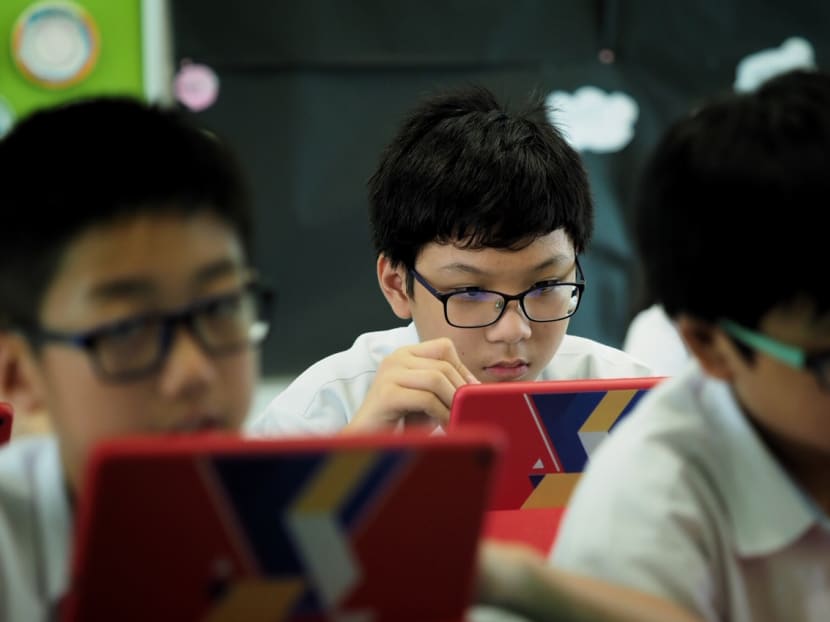Singapore’s AI strategy to focus first on municipal services, education, health among others
SINGAPORE — By 2030, lift breakdowns at public housing blocks could be a thing of the past, as town councils will use artificial intelligence (AI) to predict when a breakdown might occur and provide maintenance pre-emptively.

By 2025, the Government is aiming to launch adaptive learning systems, which can provide personalised learning for students based on their needs, for mathematics in primary schools and lower secondary levels.
SINGAPORE — By 2030, lift breakdowns at public housing blocks could be a thing of the past, as town councils will use artificial intelligence (AI) to predict when a breakdown might occur and provide maintenance pre-emptively.
In schools, with an automated marking system that is AI-enabled, teachers could spend more time guiding students learning instead of burying themselves in piles of worksheets.
These are just two of the milestones that the Singapore Government is trying to achieve over the next decade or so, with the launch of its national AI strategy on Wednesday (Nov 13).
Unveiling these plans at the Singapore Fintech Festival, Deputy Prime Minister Heng Swee Keat said that the national AI strategy represents Singapore’s next step in its smart-nation journey.
The aim of launching such a strategy is to make Singapore a global hub for developing and implementing AI solutions, ensure that the Government and companies use AI to generate economic gains and improve lives, and to help the workforce here to be competent in an AI-driven economy, the Smart Nation and Digital Government Office (SNDGO) said in a press release on Wednesday.
The recently established National AI Office, which is under the SNDGO, will be heading Singapore’s AI plans and coordinating initiatives across the public and private sectors as well as academia.
Read also: Town councils to set aside more money for lift maintenance
WHAT CAN BE IMPROVED WITH AI
To begin with, the SNDGO has identified five areas which can bring about social and economic benefits to Singapore when transformed with the use of AI.
-
Freight movement
-
Municipal services
-
Healthcare
-
Education
-
Border clearance
At a technical briefing on Tuesday with the media, an SNDGO spokesperson said that these five areas were chosen because of the potential social impact it can bring to Singaporeans as well as the relative ease with which it can be achieved.
Read also: Tougher rules on lift upkeep from next month
More areas could be added to these five and any one of the five projects could be dropped if found to be not feasible, the spokesperson added.
These are the targets for the five areas:
1. Freight movement
-
Aim: More efficient transportation of goods.
-
By 2022: Develop a common data platform for various logistics players, such as port operators and freight forwarders.
-
By 2025: Use AI to plan the transportation of goods coming and leaving through sea, such as the routing and scheduling of trucks to ports and depots.
-
By 2030: Use AI to plan the transportation of goods coming and leaving through the air and land.
2. Municipal services
-
Aim: More responsive, reliable and timely neighbourhood services.
-
By 2022: Launch chatbots that residents can use to report municipal issues.
-
By 2025: Deploy sensors and other AI tools so that public housing estates can be maintained before any issues occur.
-
By 2030: Use AI to better understand how residents use various neighbourhood facilities.
3. Healthcare
-
Aim: For Singaporeans with chronic diseases such as diabetes, high blood pressure and high cholesterol to better manage and control their condition.
-
By 2022: Deploy Selena+, which stands for Singapore Eye Lesion Analyser Plus, a system which analyses retinal photographs across the nation for diabetes screening.
-
By 2025: Develop retina-based risk score for cardiovascular diseases that arise from high glucose, high blood pressure and high cholesterol.
-
By 2030: Collaborate with industry players to develop AI models for patients who have high glucose, high blood pressure and high cholesterol.
4. Education
-
Aim: More personalised learning for students.
-
By 2022: Launch automated marking system for English in primary and secondary schools.
-
By 2025: Launch adaptive learning systems, which can provide personalised learning for students based on their needs, for mathematics in primary schools and lower secondary levels.
-
By 2030: Expand automated marking and adaptive learning systems to more subjects.
5. Border clearance
-
Aim: Strengthen border security while improving traveller experience.
-
By 2022: Use AI to assess travellers’ risk profiles.
-
By 2025: 100 per cent automated immigration clearance for all travellers.
Read also: Faulty lift at Ang Mo Kio HDB block serviced every month
BUILDING THE AI INFRASTRUCTURE
Mr Heng noted that Singapore is ready to deploy AI at a national scale.
“Artificial Intelligence is one of the new frontiers in technology, and we can already see its applications in our daily lives", he said.
Some examples include AI chatbots or robo-advisers powered by AI that provide financial advice to clients.
The national AI strategy has identified five ways through which the AI infrastructure here can be strengthened:
-
Strong coordination between the Government, industry and research community so that AI solutions can be quickly deployed, tested and commercialised.
-
Training more Singaporeans for AI jobs and attract foreigners equipped with AI engineering to address the shortfall in quality and quantity of AI talent in the city-state.
-
Enabling quick and secure sharing of data between public and private sectors.
-
Educating Singaporeans to trust AI when it is used responsibly, so that AI solutions developed can be tested, patented and implemented.
-
Working with international partners.
An SNDGO spokesperson said that the Government will pump in more money to bring about the goals set in the national AI strategy, though the amount is yet to be fixed and will be decided in the next few months.
Already, S$500 million has been set aside under the Research, Innovation and Enterprise 2020 plan to build Singapore’s AI, Mr Heng said in March this year.
Separately, the Monetary Authority of Singapore (MAS) said in a press release on Wednesday that it is creating a framework for financial institutions to promote the responsible adoption of AI and data analytics.
Known as Veritas, it will help financial institutions measure their AI solutions against the principles of fairness, ethics, accountability and transparency.








